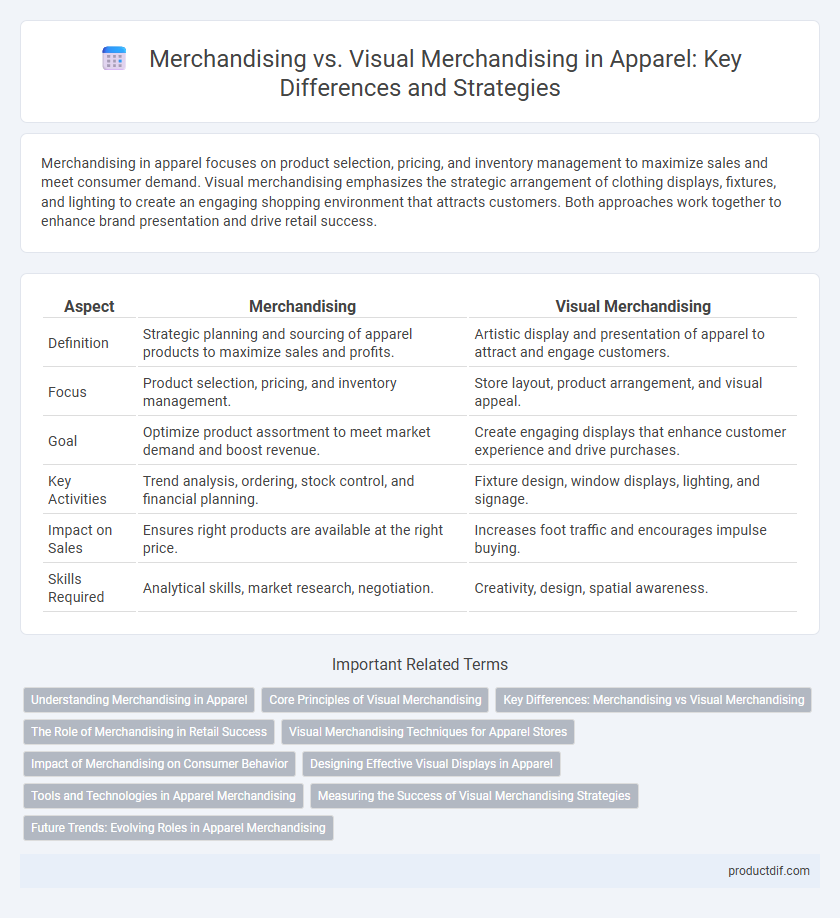Merchandising in apparel focuses on product selection, pricing, and inventory management to maximize sales and meet consumer demand. Visual merchandising emphasizes the strategic arrangement of clothing displays, fixtures, and lighting to create an engaging shopping environment that attracts customers. Both approaches work together to enhance brand presentation and drive retail success.
Table of Comparison
| Aspect | Merchandising | Visual Merchandising |
|---|---|---|
| Definition | Strategic planning and sourcing of apparel products to maximize sales and profits. | Artistic display and presentation of apparel to attract and engage customers. |
| Focus | Product selection, pricing, and inventory management. | Store layout, product arrangement, and visual appeal. |
| Goal | Optimize product assortment to meet market demand and boost revenue. | Create engaging displays that enhance customer experience and drive purchases. |
| Key Activities | Trend analysis, ordering, stock control, and financial planning. | Fixture design, window displays, lighting, and signage. |
| Impact on Sales | Ensures right products are available at the right price. | Increases foot traffic and encourages impulse buying. |
| Skills Required | Analytical skills, market research, negotiation. | Creativity, design, spatial awareness. |
Understanding Merchandising in Apparel
Merchandising in apparel involves strategic planning of product selection, pricing, and inventory management to maximize sales and meet consumer demand. It requires analyzing market trends, customer preferences, and seasonal factors to ensure the right apparel products are available at the right time. Effective merchandising drives profitability by balancing stock levels and optimizing product mix in retail stores.
Core Principles of Visual Merchandising
Visual merchandising centers on enhancing the retail space to attract customers and boost sales through strategic product placement, lighting, and signage. Core principles include maximizing visibility, creating focal points, and maintaining a cohesive brand story to engage shoppers emotionally. Unlike traditional merchandising, which focuses on inventory and pricing, visual merchandising emphasizes sensory experience and store atmosphere to influence purchasing behavior.
Key Differences: Merchandising vs Visual Merchandising
Merchandising in apparel involves strategic planning of product assortment, pricing, and inventory to maximize sales and meet consumer demand, focusing on elements like product selection and supply chain management. Visual merchandising centers on the aesthetic presentation of apparel in-store or online, using displays, lighting, and layout to enhance customer experience and drive purchasing decisions. Key differences include merchandising's emphasis on market analysis and stock control, while visual merchandising prioritizes creating appealing visual stories to attract and engage shoppers.
The Role of Merchandising in Retail Success
Merchandising in retail focuses on product assortment, pricing strategies, and inventory management to maximize sales and profitability. Visual merchandising enhances customer experience through strategic product displays, store layout, and lighting to attract and engage shoppers. Effective merchandising drives retail success by balancing product availability with appealing presentation to influence consumer purchasing behavior.
Visual Merchandising Techniques for Apparel Stores
Visual merchandising techniques for apparel stores include strategic product placement, effective use of color schemes, and engaging window displays to attract and retain customer attention. Mannequins dressed in coordinated outfits and thematic displays highlight merchandise trends, encouraging purchases and enhancing brand image. Lighting design and signage also play crucial roles in directing customer flow and emphasizing key product features within the store environment.
Impact of Merchandising on Consumer Behavior
Merchandising in apparel focuses on product assortment, pricing, and placement strategies that directly influence consumer purchasing decisions by aligning with market trends and customer preferences. Effective merchandising increases shopper engagement and drives sales by highlighting key product features and promotions in ways that appeal to target demographics. Visual merchandising complements these efforts by creating an immersive retail environment that enhances brand perception and encourages impulse buying through impactful displays and store layout.
Designing Effective Visual Displays in Apparel
Effective visual merchandising in apparel involves creating compelling displays that highlight product features and brand identity, driving customer engagement and sales. Unlike general merchandising, which focuses on product assortment and inventory management, visual merchandising emphasizes layout design, color coordination, lighting, and signage to influence shopper behavior. Strategic use of mannequins, props, and focal points transforms retail spaces into immersive environments that showcase apparel collections dynamically.
Tools and Technologies in Apparel Merchandising
Apparel merchandising utilizes data analytics software, inventory management systems, and forecasting tools to optimize product assortment and supply chain efficiency. Visual merchandising relies on digital design software, planogram tools, and augmented reality applications to create compelling in-store displays and enhance customer engagement. Both approaches integrate RFID technology and mobile apps to track merchandise performance and improve real-time decision-making in retail environments.
Measuring the Success of Visual Merchandising Strategies
Visual merchandising success is measured through key performance indicators such as sales uplift, customer dwell time, and conversion rates within apparel stores. Analyzing heat maps and foot traffic patterns helps quantify the effectiveness of product placement and display aesthetics. Customer feedback and social media engagement also provide qualitative insights into how visual elements influence purchasing behavior.
Future Trends: Evolving Roles in Apparel Merchandising
Merchandising in apparel focuses on product selection, pricing strategies, and inventory management to maximize sales and profitability, while visual merchandising emphasizes the strategic presentation of products through store layout, displays, and lighting to enhance customer experience and drive impulse purchases. Future trends in apparel merchandising include the integration of AI-driven analytics for personalized inventory forecasting and automated supply chain optimization, alongside immersive technologies like augmented reality and virtual reality enhancing visual merchandising by creating interactive and engaging in-store environments. The evolving roles reflect a convergence where data-driven decision-making and creative digital experiences jointly shape consumer engagement and retail efficiency.
Merchandising vs Visual merchandising Infographic

 productdif.com
productdif.com